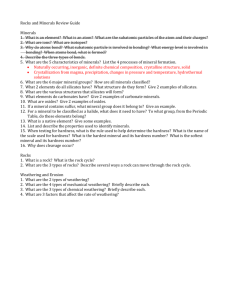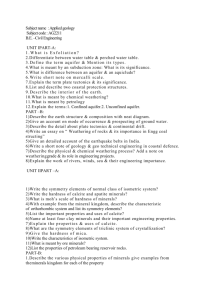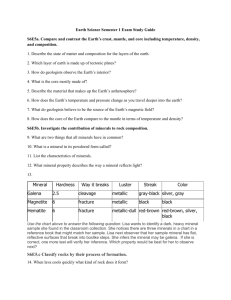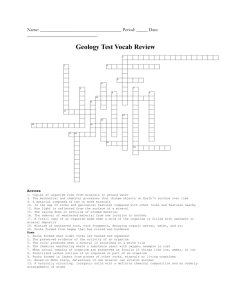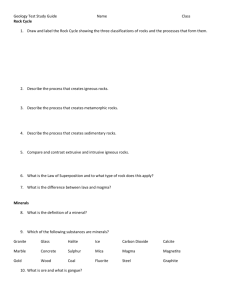Week 28 Reading Reading 45 minutes Question of the Week: How
advertisement
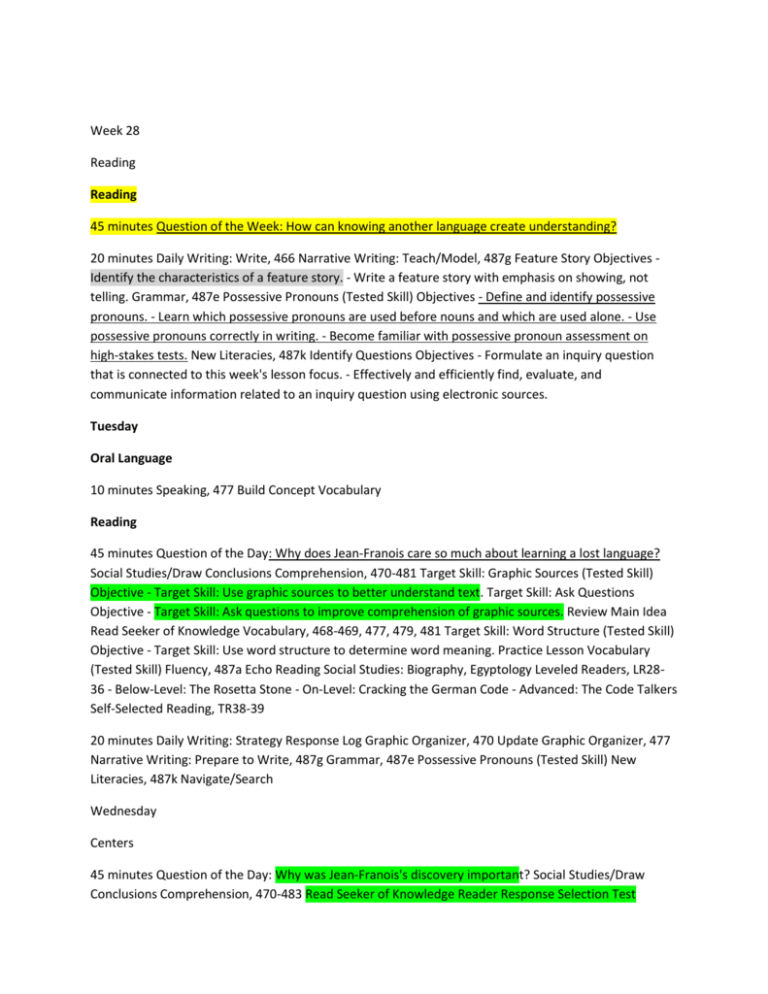
Week 28 Reading Reading 45 minutes Question of the Week: How can knowing another language create understanding? 20 minutes Daily Writing: Write, 466 Narrative Writing: Teach/Model, 487g Feature Story Objectives Identify the characteristics of a feature story. - Write a feature story with emphasis on showing, not telling. Grammar, 487e Possessive Pronouns (Tested Skill) Objectives - Define and identify possessive pronouns. - Learn which possessive pronouns are used before nouns and which are used alone. - Use possessive pronouns correctly in writing. - Become familiar with possessive pronoun assessment on high-stakes tests. New Literacies, 487k Identify Questions Objectives - Formulate an inquiry question that is connected to this week's lesson focus. - Effectively and efficiently find, evaluate, and communicate information related to an inquiry question using electronic sources. Tuesday Oral Language 10 minutes Speaking, 477 Build Concept Vocabulary Reading 45 minutes Question of the Day: Why does Jean-Franois care so much about learning a lost language? Social Studies/Draw Conclusions Comprehension, 470-481 Target Skill: Graphic Sources (Tested Skill) Objective - Target Skill: Use graphic sources to better understand text. Target Skill: Ask Questions Objective - Target Skill: Ask questions to improve comprehension of graphic sources. Review Main Idea Read Seeker of Knowledge Vocabulary, 468-469, 477, 479, 481 Target Skill: Word Structure (Tested Skill) Objective - Target Skill: Use word structure to determine word meaning. Practice Lesson Vocabulary (Tested Skill) Fluency, 487a Echo Reading Social Studies: Biography, Egyptology Leveled Readers, LR2836 - Below-Level: The Rosetta Stone - On-Level: Cracking the German Code - Advanced: The Code Talkers Self-Selected Reading, TR38-39 20 minutes Daily Writing: Strategy Response Log Graphic Organizer, 470 Update Graphic Organizer, 477 Narrative Writing: Prepare to Write, 487g Grammar, 487e Possessive Pronouns (Tested Skill) New Literacies, 487k Navigate/Search Wednesday Centers 45 minutes Question of the Day: Why was Jean-Franois's discovery important? Social Studies/Draw Conclusions Comprehension, 470-483 Read Seeker of Knowledge Reader Response Selection Test Vocabulary, 477, 481 Practice Lesson Vocabulary (Tested Skill) Fluency, 487a Model Phrasing Social Studies: Biography, Egyptology Leveled Readers, LR28-36 - Below-Level: The Rosetta Stone - On-Level: Cracking the German Code - Advanced: The Code Talkers Self-Selected Reading, TR38-39 Thursday CentersReading 45 minutes Question of the Day: What are some examples of symbols used for words that you might see today? Social Studies/Prior Knowledge Comprehension, 484-487 Read "Word Puzzles" Reading Online Objective - Examine the features of search engines. Reading Across Texts Objective - Compare and contrast across texts. Vocabulary, 484 Technology Tools Fluency, 487a Partner Reading Social Studies: Biography, Egyptology Leveled Readers, LR28-36 - Below-Level: The Rosetta Stone - On-Level: Cracking the German Code - Advanced: The Code Talkers Self-Selected Reading, TR38-39 Monitor Progress Fluency Day 4 Check 487a Check Fluency WCPM Friday Reading 45 minutes Question of the Week: To wrap up the lesson, revisit the Day 1 question. Comprehension, 487b Target Skill: Reteach Graphic Sources (Tested Skill) Objective - Use graphic sources to understand information. How Art Complements Text Objective - Analyze how art complements text. Vocabulary, 487c Practice Vocabulary Strategy (Tested Skill) Fluency, 487a Assess Reading Rate Social Studies: Communication Concept Web Leveled Readers, LR28-36 - Below-Level: The Rosetta Stone - On-Level: Cracking the German Code - Advanced: The Code Talkers Self-Selected Reading, TR38-39 Monday Pre test on 15 Monday 3/ 11/ 2013 15-5 Problem Solving: Look For a Pattern State Standards Algebra: Students continue identifying, describing, and extending numeric patterns involving all operations and nonnumeric growing or repeating patterns. Through these experiences, they develop an understanding of the use of a rule to describe a sequence of numbers or objects. Tuesday, 3/12/ 2013 library Wednesday 3/13/2013 16-1 Using Customary Units of Length Thursday 3/14/2013 16-2 Customary Units of Capacity Friday 3/15/2013 16-3 Units of Weight Science Unit 5 Monday-Wednesday lesson 1 Students will identify different properties of minerals and understand how minerals make up rocks. None Standard 3 days Lesson Vocabulary Duration mineral, luster, hardness, streak, cleavage 10 minutes Engage Duration The Big Question Transparency Let's Read Science! Draw Conclusions, p. 201 25 minutes Envision It! Have students compare gold and "fool's" gold, pp. 202-203. Use Vocabulary Smart Cards to introduce lesson vocabulary, pp. 245-248. Explore Duration My Planet Diary: Misconception p. 202, blackline master TE p. 207a. 15 minutes Explain Duration Review the Lesson Question and have students read the I will know. . . statement in order to 40 minutes help them unlock the Big Question, pp. 202-203. Have students read Mineral Crystals, Properties of Minerals, and Other Mineral Properties and answer the questions on pp. 203-207. Lightning Lab: Texture and Effervescence: Have students scratch and dip rocks in vinegar to determine their properties, p. 205. Elaborate Duration Science Notebook: Have students describe mineral samples in terms of hardness, TE p. 205. Leveled Content Readers Below-Level Earth’s Resources (Lexile Measure 690L) On-Level Types of Rocks and Minerals (Lexile Measure 780L) Advanced Mining for Rocks and Minerals (Lexile Measure 960L) See Leveled Reader Teacher Guide for Teacher Support Evaluate 10 minutes Duration Use Vocabulary Smart Cards to review lesson vocabulary, pp. 245-248. Formative Assessment: Have students complete the Lesson Check blackline master to determine whether they need additional help with lesson content, TE p. 207b. 35 minutes Professional Development Note: Content Refresher Minerals and the Body: The human body needs certain elements from minerals to function. For example, calcium is important in the formation of bones and teeth, muscle growth and contraction, blood clotting, heart rhythm, and the transmission of nerve impulses. Other elements derived from minerals that are important to the body are chromium, copper, iodine, magnesium, manganese, sodium, phosphorus, potassium, and zinc. For example, chromium is used by the body to bring glucose from the blood into cells. You can find chromium in pepper. Hardness of Mineral Samples: The Mohs Scale of Hardness was developed in 1812 by German scientist Friedrich Mohs. Common materials can be used to test the hardness of mineral samples. For example, any mineral that can be scratched with a fingernail has a hardness of about 2.5, a fingernail's hardness. Impurities in Minerals: All minerals contain at least small amounts of impurities. Impurities are substances that are not a necessary part of the mineral. Some minerals get their color from impurities that are dissolved in the crystals. Because the dissolved impurities can vary in different samples of the same mineral, the color of a mineral is not always the same. For example, pure quartz is colorless, but because of various impurities, its color can range from brown to pink to deep purple. Effervescence: Putting vinegar or a weak hydrochloric acid solution on calcite is an example of an effervescence test. Effervescence tests help scientists test for the presence of carbonate (CO3) in a mineral. Calcite effervesces easily, while other carbonate minerals will only fizz if the mineral is powdered, or if the acid is heated. Some minerals, such as dolomite, change the color of the acid during the reaction. Science Thursday –Monday Students will describe the three categories of rocks and know how they are formed. medicine cup (30 mL or 1 oz), clear plastic cup (10 oz), 30 mL each of sand, salt, coffee, sugar, and clay soil, small paper clip, rubber band, crayon (small piece), p. 208, TE p. 217a, Standard 3 days Lesson Vocabulary Duration igneous, sedimentary, metamorphic 10 minutes Engage Duration Envision It! Have students discuss what they think will happen when lava and water interact, pp. 208-209. 25 minutes Use Vocabulary Smart Cards to introduce lesson vocabulary, pp. 245-248. Explore Duration Explore It! What can you learn from rock layers? p. 208, blackline master TE p. 217a. 15 minutes Explain Duration Review the Lesson Question and have students read the I will know. . . statement in order to help them unlock the Big Question, pp. 208-209. Have students read Classifying Rocks, Igneous Rocks, Sedimentary Rocks, Metamorphic Rocks, and The Rock Cycle and answer the questions on pp. 209-217. Lightning Lab: Rock Model: Have students model a type of rock using clay and then describe the type of rock they made, p. 214. 60 minutes Elaborate Duration Tell students about two types of lava and have them infer which type cools more slowly, TE p. 211. Leveled Content Readers Below-Level Earth’s Resources (Lexile Measure 690L) On-Level Types of Rocks and Minerals (Lexile Measure 780L) Advanced Mining for Rocks and Minerals (Lexile Measure 960L) See Leveled Reader Teacher Guide for Teacher Support Evaluate 10 minutes Duration Use Vocabulary Smart Cards to review lesson vocabulary, pp. 245-248. Formative Assessment: Have students complete the Lesson Check blackline master to determine whether they need additional help with lesson content, TE p. 217b. 35 minutes ELL Support 1. Content and Language: Show students a small and large ball. Say the words small and large. Have students repeat and demonstrate comprehension by identifying other small and large objects. Introduce synonyms, such as little and big, tiny and huge. Have students use them in their descriptions. 2. Frontload the Lesson: Preview the lesson with a picture walk. Ask: What do many of the pictures have in common? (Rocks) Have students predict what the lesson might be about. Have them check their predictions at the end of the lesson. 3. Comprehensible Input: Have students work in pairs using a three-column chart with the headings "Type of Rock," "Made From," and "How It Forms." Students might also wish to add fourth and fifth columns with the headings "Example" and "Use." Have them share their charts with another pair. If students have difficulty explaining verbally how rocks form, help them draw a diagram to illustrate the process. Professional Development Note: Content Refresher Igneous Rocks: Igneous rocks that are formed from magma that reaches Earth's surface are called extrusions. Igneous rocks formed from magma that cools below Earth's surface are called intrusions. Volcanic activity produces extrusions as lava flows down the side of a volcano, eventually hardening. Other volcanic extrusions occur when magma is ejected from a volcano as a result of violent gaseous explosions. The amount of magma released from a volcano during a violent explosion can be as much as 3,000 cubic kilometers (about 720 cubic miles). Sedimentary Rocks: Sedimentary rocks can reveal clues about what Earth was like millions of years ago. Shale was formed from the accumulation of sediment in ocean basins and may indicate an ancient ocean or mouth of a river. Sandstone was formed from sand and may indicate dunes, desert, or coastal areas existed there in ancient times. Coal was formed from dead trees, ferns, and other plants and may indicate an ancient forest or wetland existed there long ago Spelling The Seeker of Knowledge Generalization The sound /j/ can be spelled ge and dge: charge, bridge. The sounds /ks/ and /kw/ can be spelled xc, x, and qu: except, expect, equal. 1. village Challenge Words 2. except 21. expedition 3. explain 22. aquarium 4. quick 23. inquire 5. charge 24. frequent 6. bridge 25. advantage 7. knowledge 8. question 9. equal 10. queen 11. excited 12. expect 13. Texas 14. fudge 15. excellent 16. exercise 17. quart 18. liquid 19. quilt 20. expert


